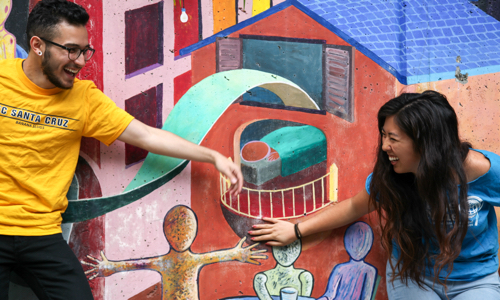UC Santa Cruz offered admission to 27,216 students for the upcoming academic year with a record number of offers made to California community college students.
With the largest applicant pool in campus history and a smaller enrollment target than the previous year, the campus increased its admission selectivity, based on preliminary numbers released today (July 6) by the UC Office of the President. This year’s admitted freshmen had an average GPA of 3.89, average SAT scores of 1819 (old), 1277 (new), and an average ACT of 28.
The largest portion of admissions offers—19,258 or 70 percent—are to California students. Total freshmen admission offers declined by 5 percent, a reflection of an exceptionally large entering class for fall 2016 and smaller enrollment targets for fall 2017. The admission rate for California community college transfer students rose by 13.6 percent, the highest one-year increase of any of the UC campuses.
UC Santa Cruz is fully committed to enrolling one California resident transfer for every two California resident freshmen as soon as possible, said Chancellor George Blumenthal. The campus expects to enroll 19 percent more California transfers compared to fall 2013 when it began to screen for major preparation requirements.
“We are committed to balancing student success and access,” Blumenthal said. “We are accepting winter transfer applications as well and will continue to be open for winter until this goal is achieved. This summer, I am meeting with several of our Regents, state leaders, and regional community college presidents as we continue to enhance and expand our recruitment and enrollment efforts.”
The campus this fall anticipates welcoming about 4,500 new California undergraduates, who have selected the campus for its exceptional focus on social justice, reputation for high-impact research conducted by faculty, student resource centers, and opportunities to work with faculty on research projects and performances.
The campus expects to enroll approximately 3,960 new freshmen. The vast majority—roughly 3,400 (86 percent)—hail from California with approximately 560 (14 percent) coming from other states or countries.
The campus significantly increased the number of offers (fall and winter quarters) to California community college students, offering a spot to 6,152 students, a 13 percent increase from last year and a 31 percent increase from 2015.
"The transfer student admit numbers are particularly gratifying given all the work we're doing with community colleges throughout the state. We are seeing more and more well-qualified transfer students applying to our campus and our admit figures reflect just that," said Director of Admissions Michael McCawley. “I'm particularly pleased that we were able to admit at least one student from 113 of the 114 community colleges, underscoring our commitment to serve all the community colleges in California."
Faculty and staff are preparing to welcome the new class into UC Santa Cruz’s distinctive residential colleges, Summer Academies, Scholars Program, and new federally funded programs related to the campus’s Hispanic Serving Institution (HSI) status, and ever-expanding opportunities for undergraduate research, internships, and creative projects with world-class faculty.
Compared to last year, the campus expects to enroll approximately 300 more California undergraduate full-time equivalents (FTE) during the regular 2017-18 academic year and summer. However, because of the very large freshmen class last year that will be continuing this year, and despite record applications, the campus will bring in roughly 425 fewer new California undergraduates than a year ago.
Campus diversity remains strong with the percentage of admitted African American, American Indian, Asian American, and Chicano/Latino student remaining steady.
The campus admitted 824 California African American students, accounting for 4.3 percent of all California admits and up from 3.7 percent last year. The campus remains committed to reaching a critical mass of African American undergraduates in order to create a more inclusive environment. The near-term goal is to increase from the current 4 percent of overall undergraduate enrollments to 5 percent. Students, staff, faculty, and alumni continue to collaborate on ways to enhance the campus climate.
Recruiting students from other countries and states is also part of the campus commitment to creating an inclusive campus, as all perspectives contribute to a dynamic social and cultural atmosphere on campus. The campus offered admission to 3,082 out-of-state students and 4,876 international freshmen. The campus anticipates having about 600 new freshman and transfer international and out-of-state undergraduates enroll this fall.



